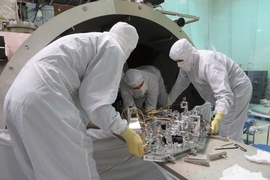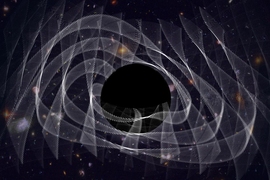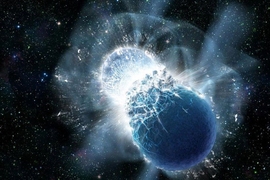Danielle Frostig spent the last Friday in February with the rest of the Astronomical Instrumentation Team at MIT, carefully packing an astronomical instrument bound for Chile. This instrument, a prototype of the larger, complete spectrograph, which will image some of the faintest and oldest stars, will be mounted on the Magellan Telescope in Las Campanas, Chile. “I’ve never thought of shipping crates or tax forms before,” confesses Frostig, a graduate student in the group of Rob Simcoe, director of MIT Kavli Institute for Astrophysics and Space Research and the Francis Friedman Professor of Physics, “but I’m happy to be involved.” Those boxes are currently sitting at the observatory waiting for the stay-at-home rules and travel restrictions related to Covid-19 to lift so the team can fly down and install it on the telescope.
Working with astronomical instruments has allowed Frostig to delve into all aspects of a research project, from designing and building the actual instrument, shipping it to a different state or country, and working with the data it collects. “I really understand what I’m doing with my science from the basis of: ‘what is this instrument doing?’ and ‘how does it work?’” she says.
Astronomical instruments have also allowed Frostig to combine her love of math and astrophysics with creating art. Growing up with the University of California at Irvine (UCI) campus in her backyard, Frostig would go to visitor nights at UCI’s observatory with her dad. At the same time, she also attended an arts middle and high school. “Art was a huge part of my life for a long time, but when I was diving into astrophysics in college, I wasn’t creating much art,” Frostig remembers. That’s where astronomical instrumentation comes in. “I get to build things, which I’ve always loved doing, and do astrophysics,” she says.
Frostig has worked on parts of the Large Lenslet Array Magellan Spectrograph (LLAMAS) imaging tool prototype, but the main focus of her research is WINTER, a wide-field camera mounted on a telescope that will survey the cosmos for infrared light. “The question we’re trying to solve with WINTER is: How are the heaviest elements in the universe produced?” says Frostig.
The lighter elements in the periodic table, from hydrogen up to iron, are created in the cores of massive stars. As for those elements that are heavier than iron? Science is still figuring that out. “We suspect that they are produced by the r-process, which is the rapid neutron-capture process,” says Frostig. Direct evidence for neutron star mergers as the origin of r-process elements comes from only one event: Gravitational Wave 170817 (GW170817) detected by the Laser Interferometer Gravitational-Wave Observatory (LIGO) in August 2017.
Unlike previous gravitational waves observed by LIGO, which were produced by the collision of two black holes, GW170817 was caused by the merging of two neutron stars, which are the smallest and densest stars, holding a mass 10 to 29 times greater than our sun. “The two neutron stars spiraled into each other, merged, and created a big explosion that we could ‘hear’ in LIGO gravitational waves, but also see with conventional telescopes,” says Frostig. Most significantly, there’s evidence that the collision of these two neutron stars generated enough energy to produce the heavier elements.
“But right now we only have one data point,” Frostig says. The purpose of WINTER is to locate more of these events in the sky, and Frostig and her group believe infrared light is the way to find them. As the neutron stars circle each other in ever-increasing speeds, they’re torn apart, with their remnants forming a cloud of dust that glows infrared. It’s this cloud of dust that WINTER will detect. “We’re taking this infrared imaging technology from the defense sector and applying it to astronomy, so that we can be on the sky on the right wavelength to study how these elements are formed,” Frostig says.
WINTER will work in collaboration with LIGO during its fourth observing run, which starts in 2022. “LIGO is expecting to see these gravitational waves once or twice a month, and they can tell us an ‘uncertainty contour’ that looks kind of like a banana shape in the sky,” says Frostig. This uncertainty contour points to the region of the cosmos where the gravitational wave most likely came from and, within seconds of receiving an alert from LIGO, WINTER can start surveying that region to look for evidence that the gravitational wave was generated by a neutron star merger.
Currently working from home due to the Covid-19 pandemic, Frostig and her lab mates are focusing on WINTER’s software and tinkering with the camera’s final design. “For us, science looks similar to what it looked like before social distancing, but dispersed,” says Frostig, who now has a circuit board and oscilloscope sitting on her coffee table. Once the lab is back up and running on campus, they’ll focus on WINTER’s hardware, which can’t be done remotely.
Unlike LLAMAS, which will be attached to the much larger Magellan Telescope, WINTER will have its own dedicated telescope, a 1-meter PlaneWave telescope that can swing rapidly to look at any part of the sky. Both WINTER and the PlaneWave telescope will be shipped to Palomar Observatory in California later this year, and Frostig hopes it will be studying space by 2021. “We’re very excited to have this dedicated telescope so that we can find these events as soon as possible and tell other telescopes to also look,” says Frostig.
Dedication is something Frostig, as a 2018-19 Whiteman Fellow, understands. George J. Elbaum ’59, SM ’63, PhD ’67 and his wife Mimi Jensen established the Whiteman Fellowship (named after Elbaum’s mother, Pauline Whiteman) specifically to give graduate students the opportunity to dedicate themselves to their research projects. Receiving the fellowship has allowed Frostig to decide what aspect of her graduate education to focus on during each year. “The benefit of the fellowship is the flexibility,” says Frostig. While teaching is an area she wants to explore, the fellowship “gives me the agency to decide when I want to teach versus when I’d rather focus on research,” Frostig adds. It also helped convince her to come to MIT. “Being offered that fellowship as a prospective student showed me that the department wanted me here and really valued me as a researcher.”
Elbaum’s experience was similar when he received a fellowship from his employer to pursue graduate work at MIT. “The doctoral fellowship allowed me to select a thesis that interested me and resulted in three very exciting years of my life. So now I want to give this opportunity to some talented graduate students.”









